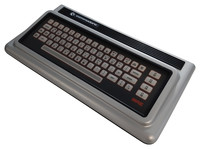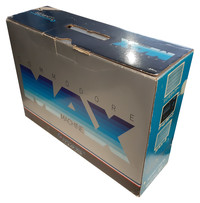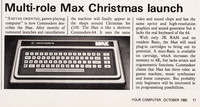Commodore MAX - RTO
| Home > Browse Our Collection > XX - REMOVED FROM COL ... DLING COLLECTION - XX > Commodore MAX - RTO |
|
The Commodore MAX is a home computer made by Commodore International and released in 1982. It is seen as the predecessor to the Commodore 64. There were only a few thousand made, and today it is considered an expensive rarity. The computer was only released in Japan, and was largely the work of Japanese engineer Yashi Terakura who was shown the chipset Al Charpentier and Bob Yannes were designing, and decided he was going to use them in a new videogame console, as the project developed, it was given programming capability. The Max shares many of the hardware parts of the C64, as machines were being developed in the US and Japan at the same time, including the 6510 processor, the 6851 SID sound chip, and the Vic II graphics chip. The keyboard is very different, being membrane keys, with a touch sensitive space bar, which in reality are not a good combination to use. There was no on board BASIC built into ROM, instead the user had to plug in a MAX BASIC Cartridge, this allowed the user to write and save to tape programs, although with just 2K of RAM they would be very limited. Without the BASIC cartridge inserted, the tape deck runs its motor continuously, and there is nothing but a black screen. There was also a Color BASIC cartridge, but this was for an even more meagre 512 bytes. Other Commodore machines such as the Vic 20 and later Commodore 16 used RAM cartridges for extra memory, but the MAX would have also have needed BASIC built into any memory cartridge. The MAX team wanted 8K of RAM, the machine originally had 4K, so the computer could have a full bit mapped display, Jack Tramiel stepped into the argument and offered 6K. As this was still not enough for the display they wanted, and to cut costs further, only 2K ended up in the machine. Apart from the standard Commodore cassette deck, carts were the only way to load in programs. There were no serial ports for disk drives, and also no way to connect a printer. There was no AV socket, video is by NTSC-J RF, and a 3.5mm jack for sound. At either side of the machine there is a single joystick port, which is the standard Atari 9 pin type. Programs were intended to run from cartridge, therefore the size of RAM was not meant to be an issue, these cartridges are all compatible with the Commodore 64, some C64 cartridges will also run on the Max, in all only 32 carts were produced, but the cartridge technology did not go to waste, as it went into the C64. The early C64 manual mentions the MAX by name, which indicates that the computer was meant to be sold worldwide as a cheaper alternative to the C64 and Vic 20. We have found an article from October 1982, which features the Max with a very different logo on the machine, stating Commodore were about to release it for just £100 as a cut down alternative to the C64. The MAX compatibility mode was used in the C64 for items like freezer cartridges, such as the Action Replay series, which allowed the user to halt a program to either be copied to disk or cassette, or to alter it in some way, adding infinite lives etc. The MAX was discontinued after only a few months. Manufacturer: Commodore Comment on This Page Other Systems Related To Commodore MAX - RTO:This exhibit has a reference ID of CH60800. Please quote this reference ID in any communication with the Centre for Computing History. |
|
















